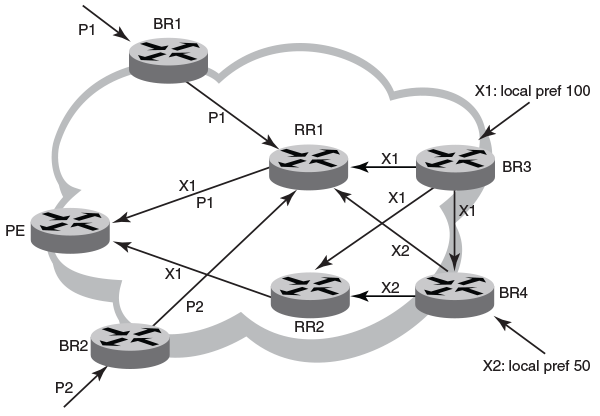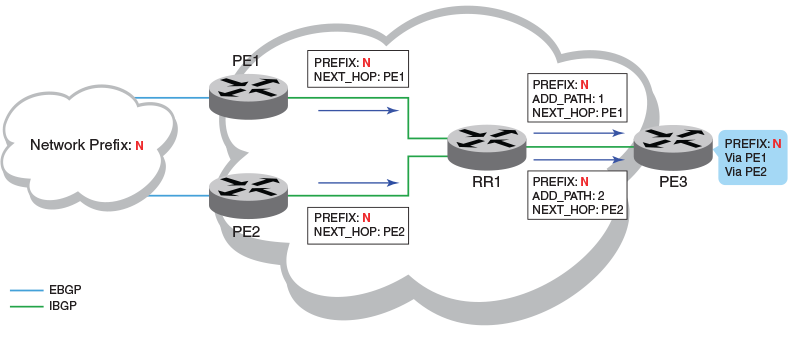BGP Additional-paths
BGP additional-paths enables the advertisement of multiple paths for the same prefix without new paths implicitly replacing the previous paths. Path diversity is achieved rather than path hiding.
A BGP device generally advertises only its best path to neighboring devices, even when multiple paths exist; the advertisement of the same prefix from the same neighbor replaces the previous announcement of that prefix. This path hiding is an implicit withdrawal behavior, which achieves better scaling but at the cost of path diversity. Path hiding can affect the efficient use of BGP multipath and path diversity, and prevent hitless planned maintenance. Upon next-hop failures, path hiding also inhibits fast and local recovery because the network must wait for BGP control plane convergence to restore traffic.
The following figure shows two types of path hiding:
- Paths P1 and P2 (for prefix P) are advertised to RR1. P1 is advertised from BR1 and P2 is advertised from BR2. RR1 selects P1 as the best path and advertises only P1 to PE.
- Paths X1 and X2 (for prefix X) are advertised to BR4. X1 is advertised from BR3 with a local preference of 100. BR4 also has path X2 with a local preference 50. However, only the best path (X1) is selected. BR3 advertises X1 to the RRs and X2 is suppressed.

BGP additional-paths enables BGP to advertise even secondary best routes, so that multiple paths for the same prefix can be advertised without the new paths implicitly replacing previous paths. BGP additional-paths provides a generic way of offering path diversity.
BGP additional-paths is implemented by including an additional four-octet value known as a path identifier (ID) for each path in the Network Layer Reachability Information (NLRI). Path IDs are unique to a peering session and are generated for each network. That is, a generated path ID is unique for each peer for each prefix.
- When the same prefix is received with the same path ID from the same peer, it is considered to be a replacement route or duplicate route.
- When the same prefix is received with a different path ID from the same peer, it is considered to be an additional path to the prefix.
To send or receive additional paths, the additional-paths capability must be negotiated. When it is not negotiated, only the best path is sent.
When the additional-paths capability is negotiated, BGP updates carry the path ID. To carry the path ID in an update message, the existing NLRI encodings are extended by prepending the path ID field, which consists of four octets.
The BGP device uses the prefix and path ID to uniquely identify a path advertised to a neighbor so as to continue to send updates for that path. The receiving BGP neighbor that re-advertises a route regenerates its own path ID that is to be associated with the re-advertised route.
The set of additional paths advertised to each neighbor can be different, and advertisement filters are provided for each neighbor.
The following figure shows a BGP additional-paths configuration that supports path diversity.

- Although route reflector RR1 has two sources for prefix N, it advertises only the best route to its peers when the additional-paths capability is not configured.
- When the additional-paths capability is configured at RR1 and PE3, PE3 receives two routes to prefix N. Receiving two routes facilitates quick network convergence and recovery:
- Using PE1 and PE2
- ECMP paths to PE1 and PE2
Configuration of BGP additional-paths
- Capability negotiation: Specifying, at the address family, peer group, or neighbor levels, whether the device can send, receive, or both send and receive additional-paths .
- Candidate path selection: Specifying, at the address family level, selection criteria for a set or sets of candidate paths to be advertised.
- Advertisement of additional-paths from the candidate set: Specifying, at the neighbor or peer group levels, a set or sets of additional-paths to advertise to a neighbor. The additional-paths to advertise must be from the candidate paths that are marked.
Advantages of BGP additional-paths
- Fast convergence and fault tolerance: When BGP additional-paths is enabled, more than one path to a destination is advertised. When one of the paths goes down, connectivity is easily restored due to the availability of backup paths. When the next-hop for the prefix becomes unreachable, the device can switch to the backup route immediately without having to wait for BGP control plane messages.
- Enhanced load-balancing capabilities: Traditionally with route reflectors (RRs) in an iBGP domain, only the best path is given to clients, even when ECMP paths exist. Giving only the best path affects load balancing. When additional paths are advertised by RRs, the clients have more effective load balancing.
Considerations and limitations for BGP additional-paths
- BGP additional-paths is supported for
the following BGP address families:
- IPv4 unicast
- IPv4 unicast VRF
- IPv6 unicast
- IPv6 unicast VRF
- BGP additional-paths is not supported for BGP VPNv4 unicast, BGP VPNv6, and BGP EVPN address families.
- Changes in the capability of receiving or sending additional-paths are reflected only after the BGP session is restarted.
- RIB-in:
- When BGP additional-paths is not configured, only one NLRI for each prefix for each peer is supported. Any additional NLRI update for the same prefix from the same peer replaces the existing one.
- When BGP additional-paths is configured, a device can receive multiple NLRI advertisements for the same prefix from the same peer that are uniquely identified by NLRI path identifiers.
- The maximum number of additional-paths for each peer for each prefix is 128.
- RIB-out:
- The maximum number of paths that can be advertised for each prefix is 16. When more than 16 paths for a prefix exist in the RIB-in, only 16 can be advertised.
- For smooth RIB-out processing, the number of RIB-in paths for any prefix should be maintained within the range from 1 through 16. RIB-out processing time increases exponentially in the scaled scenarios.
Upgrade and downgrade considerations for BGP additional-paths
BGP additional-paths configuration should be removed before a downgrade to a version of software that does not support additional-paths.
When BGP additional-paths is enabled and the configuration saved, an error message occurs when the software is downgraded to an earlier version that does not support the feature. To avoid this error message, the BGP additional-paths configuration should be removed before the downgrade takes place and reconfigured when upgraded again.

